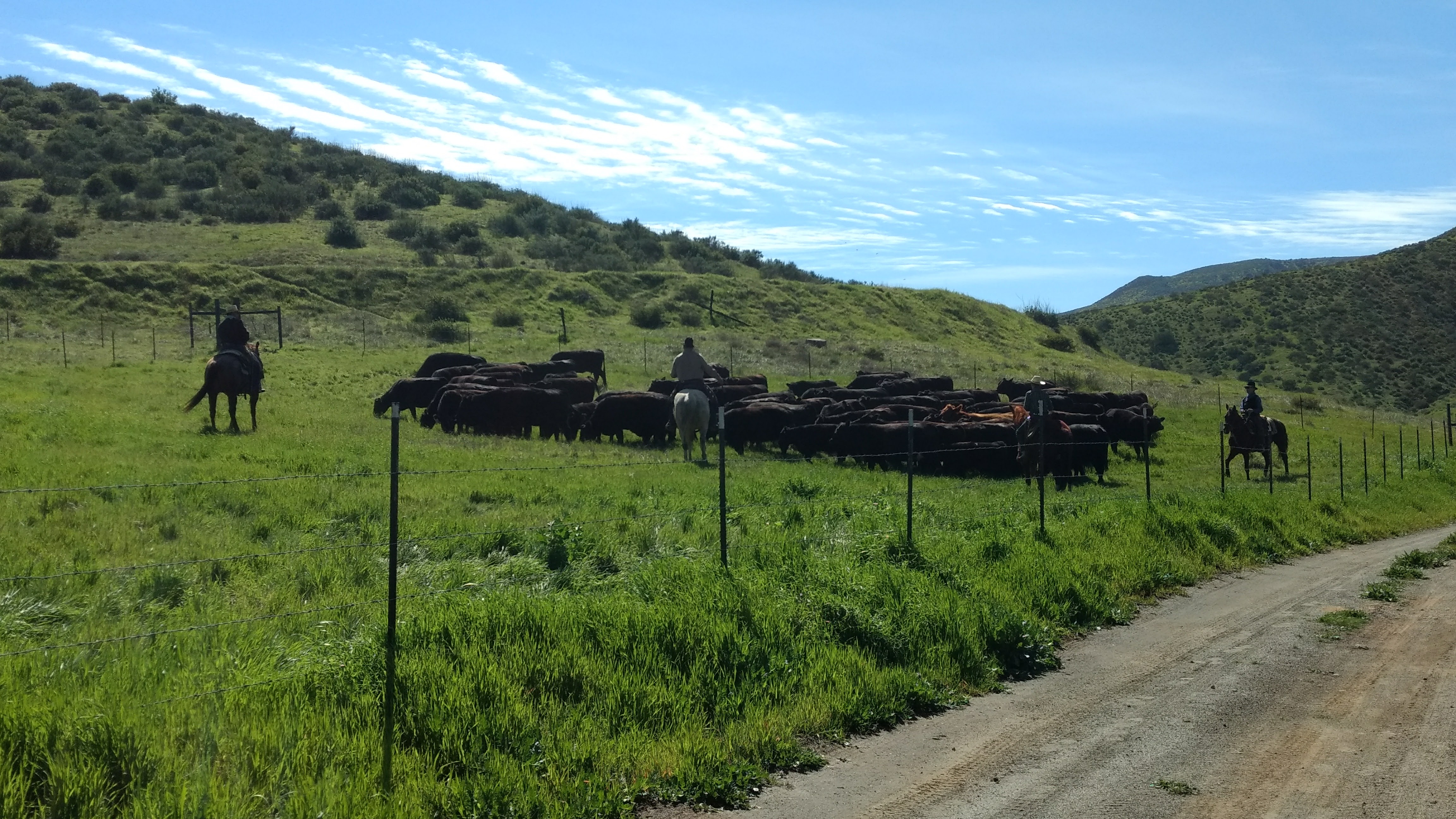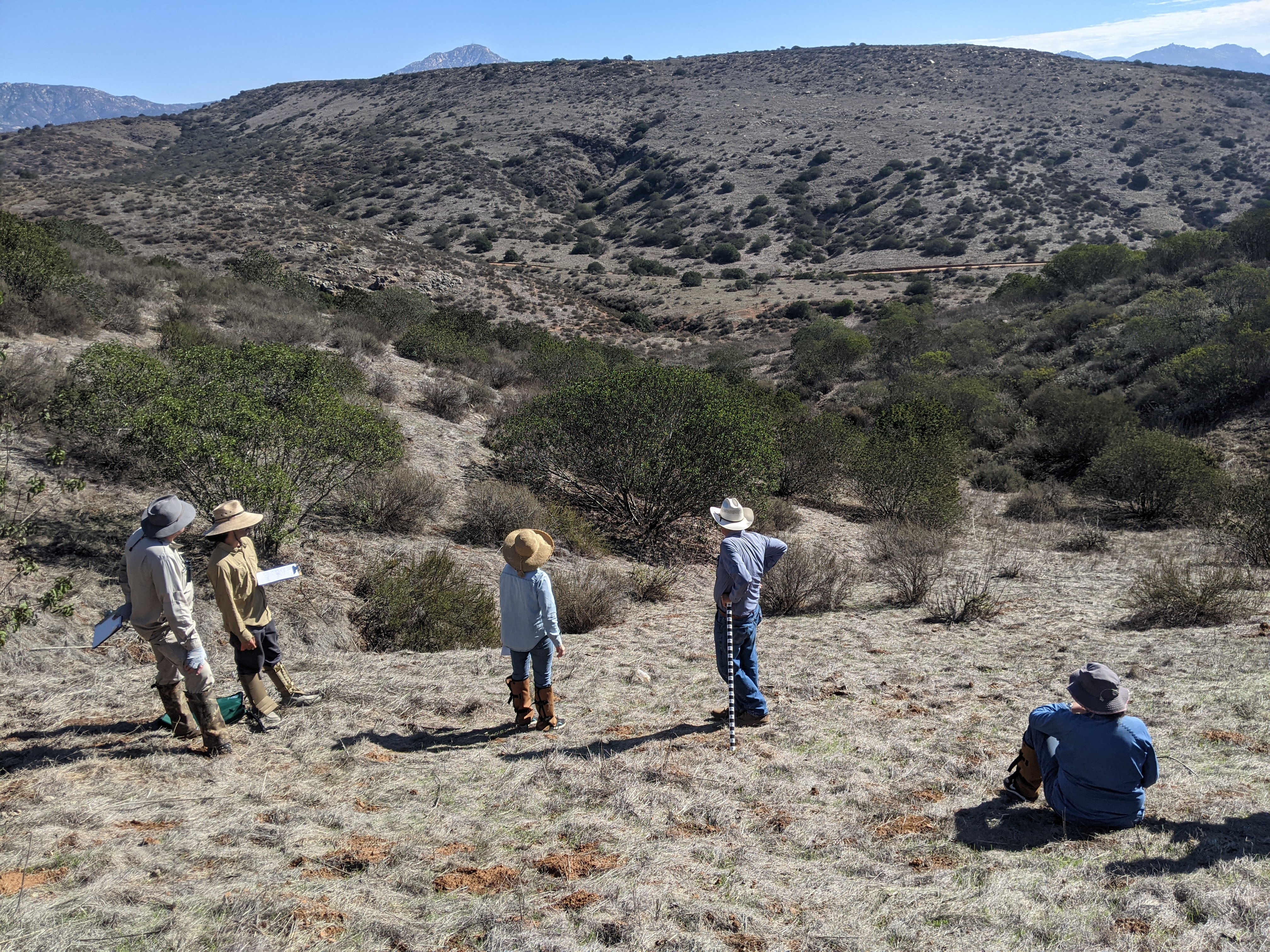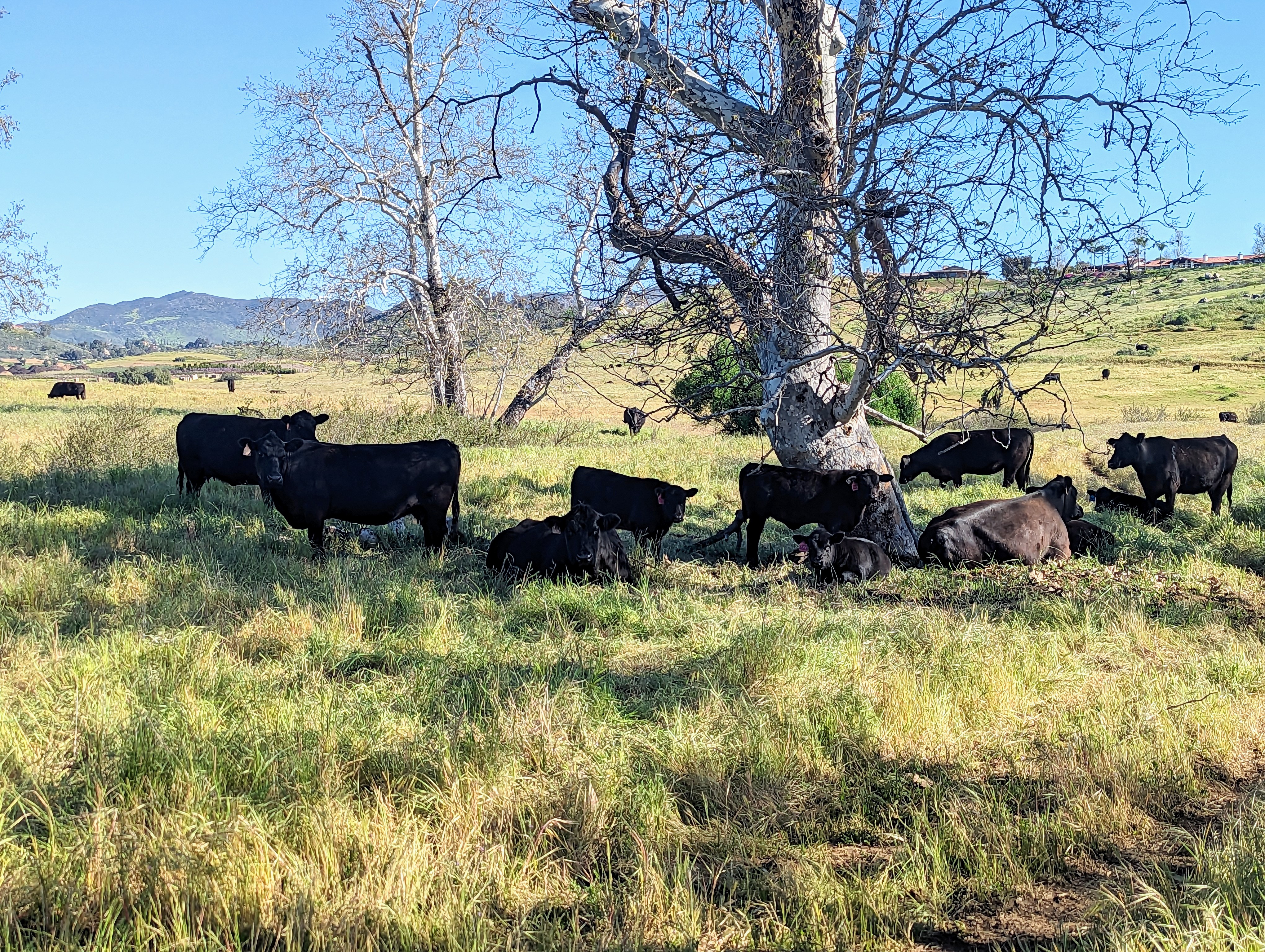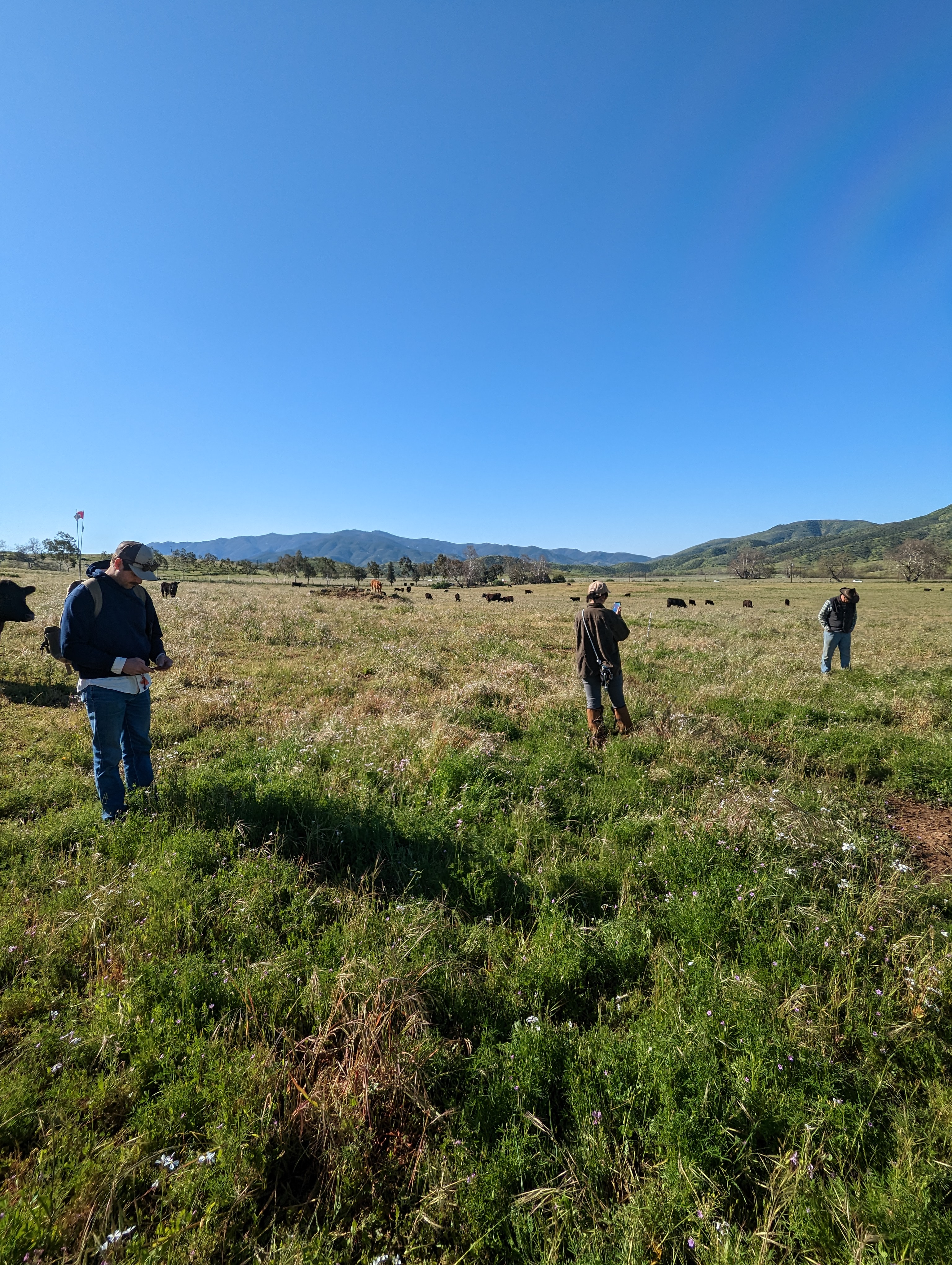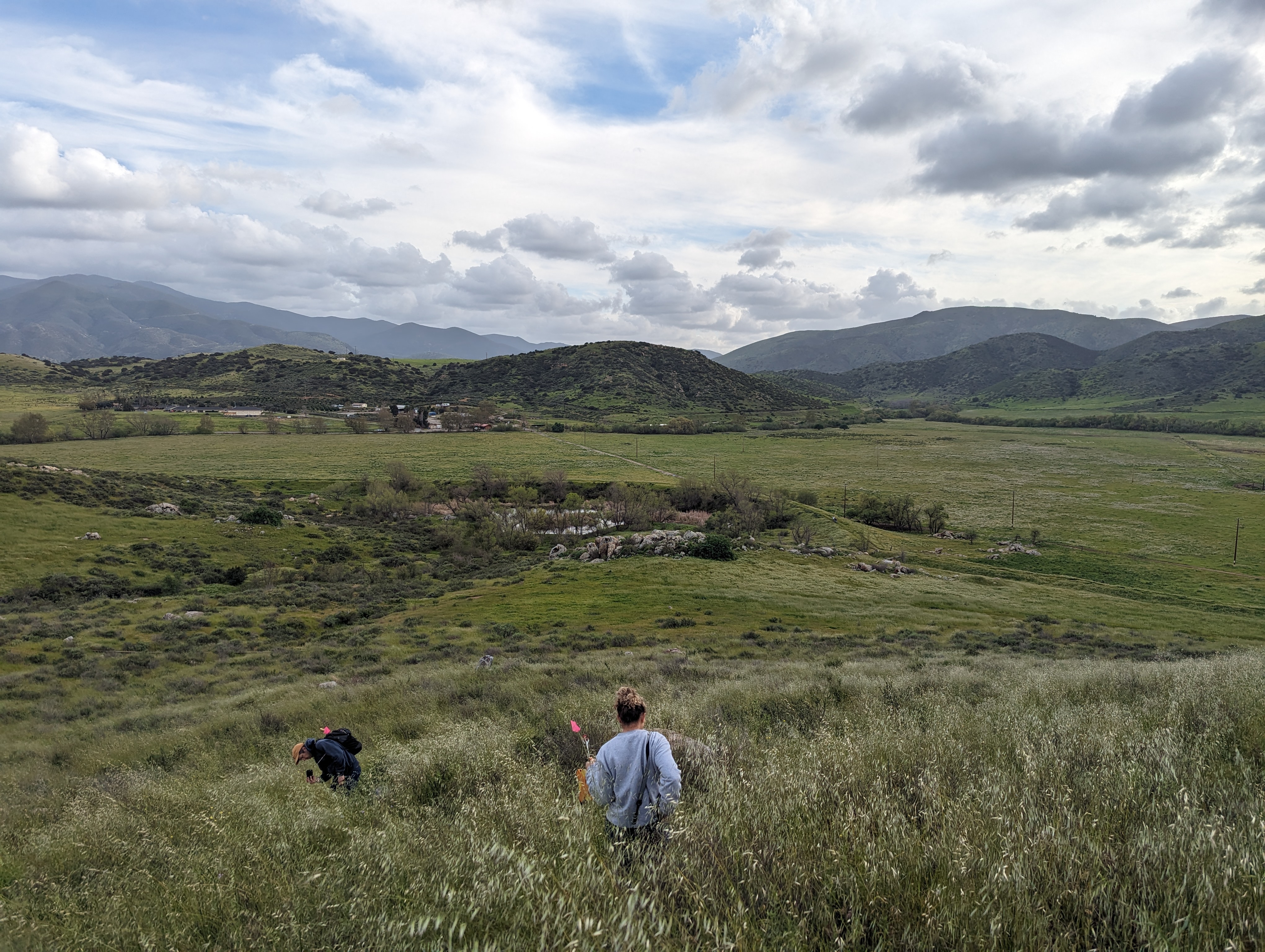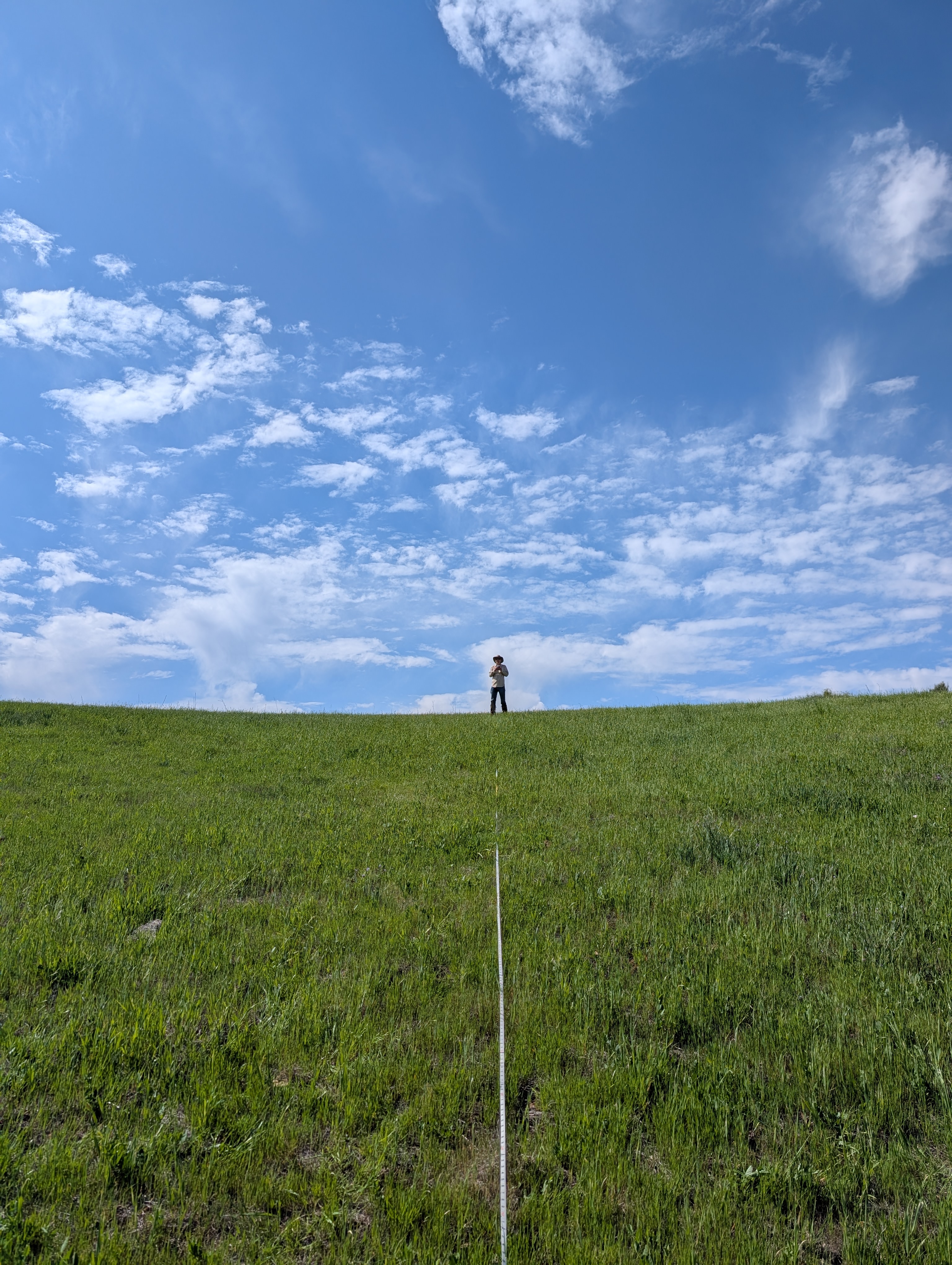Regional Grazing Monitoring Plan
This project evaluates using grazing as a management tool for degraded grasslands and coastal sage scrub habitat. Pilot projects will be conducted to look at the efficacy of grazing as management tool and necessary monitoring methods. The project was designed to answer four primary questions (and their associated objectives): 1) How effective is grazing at reducing fire risk? 2) Can grazing effectively enhance disturbed native grassland and forb habitats 3) Can grazing enhance disturbed native coastal sage scrub habitat? 4) Can grazing reduce nonnative grass and forb cover in disturbed coastal sage scrub to increase native shrub cover and bare ground and improve habitat for MSP species such as Quino checkerspot butterfly (Euphydryas editha quino), California gnatcatcher (Polioptila californica), black-tailed jackrabbit (Lepus californicus), burrowing owl (Athene cunicularia hypugaea), and Stephen' kanagroo rat (Dipodomys stephensi)? Initial study sites were established at Rancho Jamul Ecological Reserve and Hollenbeck Canyon Wildlife Area, and the project has recently expanded to Ramona. This is a SANDAG-funded project.
Project Focus
American badger, Arroyo toad, Black-tailed Jackrabbit, California Gnatcatcher, California ground squirrel, Ferruginous hawk, Golden eagle, Grasshopper Sparrow, Loggerhead Shrike, Quino checkerspot butterfly, Southwestern pond turtle, Stephens' kangaroo rat, Western burrowing owl
coastal sage scrub, grassland, vernal pools and alkali playa
HOLLENBECK CANYON WILDLIFE AREA, RANCHO JAMUL ECOLOGICAL RESERVE
Kaveh Motamed
SANDAG
James Bartolome; Lynn Huntsinger
San Diego Management and Monitoring Program
California Department of Fish and Wildlife; City of San Diego Public Utilities; Conservation Biology Institute; County of San Diego, Department of Parks and Recreation; Endangered Habitats Conservancy; Escondido Creek Conservancy; Michael White Consulting; National Resources Conservation Service; Rangeland Conservation Science; Resource Conservation District (RCD) of Greater San Diego; San Diego Habitat Conservancy; San Diego Zoo Institute for Conservation Research; SANDAG; The Nature Conservancy; U.S. Fish and Wildlife Service; U.S. Forest Service; U.S. Geological Survey; University of California Agriculture and Natural Resources; University of California, Berkeley
Sarah McCutcheon
Sarah McCutcheon
Sarah McCutcheon
Felix Ratcliff; Joyce Qiao
Otay tarplant Deinandra conjugens
Goal: Maintain or enhance existing Otay tarplant occurrences to ensure multiple conserved occurrences with self sustaining populations to increase resilience to environmental and demographic stochasticity, maintain genetic diversity, and ensure persistence over the long term (>100 years) in native and non native grassland vegetation communities.
MGT-DEV-BMP DEICON-3
Management units: 3
In 2017 continue the collaboration with the South County Grasslands Project initiated in 2014 to develop BMPs for landscape-scale restoration of Otay tarplant habitat in MU3 that includes testing methods of seeding and invasive plant control so that nonnative plants and thatch are reduced to less than 20% relative cover and thatch to <5 cm tall and native plants to at least 25% relative cover. These percent cover criteria could be revised based on data collected from an acceptable reference site.
| Action | Statement | Action status | Projects |
|---|---|---|---|
| DEV-1 | Conduct experiments using mowing, prescribed burns herbicide and potentially grazing to control invasive non-native grasses and forbs at a landscape-scale and to compare drill seeding versus hand broadcast seeding in order to determine economical and effect. | in progress | Regional Grazing Monitoring Plan |
| DEV-2 | Based upon experiment results, develop explicit BMPs for the restoration of Otay tarplant. Submit project metadata, monitoring datasets and BMP report to MSP web portal. | in progress |
| Criteria | Deadline year |
|---|---|
| BMPs Developed for Restoration of Otay tarplant by 2017 | 2021 |
| Threat Name | Threat Code |
|---|---|
| Altered fire regime | ALTFIR |
| Human uses of the Preserves | HUMUSE |
| Invasive plants | INVPLA |
| Loss of connectivity | LOSCON |
| Urban development | URBDEV |
coastal sage scrub
Goal: Maintain, enhance and restore coastal sage scrub on Conserved Lands in the MSPA that supports or has the potential to support VF species (i.e., cliff spurge, Palmer's goldenbush, San Diego barrel cactus, snake cholla, Blaineville's horned lizard, California gnatcatcher, San Diego black-tailed jackrabbit) and to incidentally benefit a diverse array of other species (e.g., San Diego thornmint, Hermes copper, Quino checkerspot, coastal cactus wren) so that the vegetation community has high ecological integrity, and these species are resilient to environmental stochasticity, catastrophic disturbances and threats, such as very large wildfires, invasive plants and prolonged drought, and will be likely to persist over the long term (>100 years).
MGT-DEV-BMPPL COSASC-5
Management units: 3, 4, 5, 6, 8, 9, 10, 11
In 2020-2021, begin implementing and testing the plan for landscape-scale invasive plant control of coastal sage scrub and grassland ecosystems at 3 or more selected sites with extensive (at least 200 acres) coastal sage scrub and grasslands with large nonnative grass component, using livestock that are most suitable and feasible to manage for the grazing study, effective at controlling invasive nonnative annual grasses, and that are least likely to impact native plant and animal species. Test management methods for enhancing coastal sage scrub to reduce invasive plants and to increase native forb, grass and shrub cover and bare ground. Test management techniques for nonnnative grassland to improve habitat for MSP species such as Quino checkerspot, burrowing owl, golden eagle, grasshopper sparrow, black-tailed jackrabbit and American badger. Incorporate layered treatments of different control methods in the experimental design.
| Action | Statement | Action status | Projects |
|---|---|---|---|
| DEV-1 | Initiate adaptive management at 3 or more selected sites with extensive areas (≥200 acres) of coastal sage scrub and grasslands with a large nonnative annual grass component. Test management methods for enhancing coastal sage scrub to reduce invasive plants and to increase native forb, grass and shrub cover and bare ground. Test management techniques for nonnnative grassland to improve habitat for MSP species such as Quino checkerspot, burrowing owl, golden eagle, grasshopper sparrow, black-tailed jackrabbit and American badger. Incorporate layered treatments of different control methods in the experimental design | on hold | |
| DEV-2 | Select livestock species to use in the grazing study that are most feasible to manage, effective at controlling invasive non-native annual grasses, and that are least likely to impact native plant and animal species. | on hold | Regional Grazing Monitoring Plan |
| DEV-3 | Conduct experimental trials at multiple sites with sufficient replicates to evaluate the timing and duration of prescribed fire, grazing, stocking rates, and frequency of grazing over =3 years with varying amounts and timing of precipitation. | on hold | Regional Grazing Monitoring Plan |
| DEV-4 | Include in the experimental design different seeding trials to determine the combination of invasive plant control and re-seeding techniques that results in the most effective restoration outcomes. | on hold | |
| DEV-5 | Monitor plant community composition and cover to determine if grazing effectively controls non-native annual grasses, forbs and alters native plant community composition, structure, and cover. | on hold | Regional Grazing Monitoring Plan |
| DEV-6 | Collect covariates to evaluate impacts of grazing, prescribed fire and other control methods to native plant and animal species and to ecosystem processes. | on hold | Regional Grazing Monitoring Plan |
| DEV-7 | Compare results of grazing, prescribed fire with South County Grassland study results to control invasive grasses and forbs using herbicides and mechanical treatments. | on hold | |
| DEV-8 | If utilizing grazing, presecribed fire or other methods or combination of methods to manage annual grass in coastal sage scrub achieves the desired outcomes and does not have unintended consequences (introduction and or expansion of invasive species, change in shrub structure, impact to native plants and animals or ecological processesetc.) on the coastal sage scrub and grassland vegetation communities and it is cost effective, develop a BMP as a management tool. If a BMP is developed it should include specific guidelines on how to use grazing, fire and/or other methods as a management tool and the costs to utilize it. | on hold | |
| DEV-9 | Submit project metadata, monitoring datasets and report to the MSP web portal | on hold |
| Threat Name | Threat Code |
|---|---|
| Altered fire regime | ALTFIR |
| Climate change | CLICHN |
| Invasive plants | INVPLA |
| Loss of ecological integrity | ECOINT |
grassland
Goal: Enhance and restore native grasslands and forblands and manage nonnative grasslands on Conserved Lands in the MSPA that support or have the potential to support VF species (i.e., grasshopper sparrow and San Diego black-tailed jackrabbit) and to incidentally benefit a diverse array of other species (e.g., Quino checkerspot, burrowing owl, golden eagle, Stephen's kangaroo rat) so that the vegetation communities have high ecological integrity, and these species are resilient to environmental stochasticity and will be likely to persist over the long term (>100 years).
MGT-DEV-BMPPL GRASSL-5
Management units: 3, 4, 5, 6, 8, 9, 10, 11
In 2020-2021, begin implementing and testing the plan for landscape-scale invasive plant control of coastal sage scrub and grassland ecosystems at 3 or more selected sites with extensive ( less than 200 acres) coastal sage scrub and grasslands with large nonnative grass component, using livestock that are most suitable and feasible to manage for the grazing study, effective at controlling invasive nonnative annual grasses, and that are least likely to impact native plant and animal species. Test management methods for enhancing coastal sage scrub to reduce invasive plants and to increase native forb, grass and shrub cover and bare ground. Test management techniques for nonnnative grassland to improve habitat for MSP species such as Quino checkerspot, burrowing owl, golden eagle, grasshopper sparrow, black-tailed jackrabbit and American badger. Incorporate layered treatments of different control methods in the experimental design
| Action | Statement | Action status | Projects |
|---|---|---|---|
| DEV-1 | Initiate adaptive management at 3 or more selected sites with extensive areas (≥200 acres) of coastal sage scrub and grasslands with a large nonnative annual grass component. Test management methods for enhancing coastal sage scrub to reduce invasive plants and to increase native forb, grass and shrub cover and bare ground. Test management techniques for nonnnative grassland to improve habitat for MSP species such as Quino checkerspot, burrowing owl, golden eagle, grasshopper sparrow, black-tailed jackrabbit and American badger. Incorporate layered treatments of different control methods in the experimental design | on hold | |
| DEV-2 | Select livestock species to use in the grazing study that are most feasible to manage, effective at controlling invasive non-native annual grasses, and that are least likely to impact native plant and animal species. | on hold | Regional Grazing Monitoring Plan |
| DEV-3 | Conduct experimental trials at multiple sites with sufficient replicates to evaluate the timing and duration of grazing, stocking rates, and frequency of grazing over =3 years with varying amounts and timing of precipitation. | on hold | Regional Grazing Monitoring Plan |
| DEV-4 | Include in the experimental design different seeding trials to determine the combination of invasive plant control and re-seeding techniques that results in the most effective restoration outcomes. | on hold | |
| DEV-5 | Monitor plant community composition and cover to determine if grazing effectively controls non-native annual grasses, forbs and alters native plant community composition, structure, and cover. | on hold | Regional Grazing Monitoring Plan |
| DEV-6 | Collect covariates to evaluate impacts of grazing, prescribed fire and other control methods to native plant and animal species and to ecosystem processes. | on hold | |
| DEV-7 | Compare results of grazing, prescribed fire with South County Grassland study results to control invasive grasses and forbs using herbicides and mechanical treatments. | on hold | |
| DEV-8 | If utilizing grazing, presecribed fire or other methods or combination of methods to manage annual grass in coastal sage scrub achieves the desired outcomes and does not have unintended consequences (introduction and or expansion of invasive species, change in shrub structure, impact to native plants and animals or ecological processesetc.) on the coastal sage scrub and grassland vegetation communities and it is cost effective, develop a BMP as a management tool. If a BMP is developed it should include specific guidelines on how to use grazing, fire and/or other methods as a management tool and the costs to utilize it. | on hold | Regional Grazing Monitoring Plan |
| DEV-9 | Submit project metadata, monitoring datasets, and monitoring report to the MSP web portal | on hold |
| Threat Name | Threat Code |
|---|---|
| Altered fire regime | ALTFIR |
| Climate change | CLICHN |
| Invasive plants | INVPLA |
| Loss of ecological integrity | ECOINT |
coastal sage scrub
Goal: Maintain, enhance and restore coastal sage scrub on Conserved Lands in the MSPA that supports or has the potential to support VF species (i.e., cliff spurge, Palmer's goldenbush, San Diego barrel cactus, snake cholla, Blaineville's horned lizard, California gnatcatcher, San Diego black-tailed jackrabbit) and to incidentally benefit a diverse array of other species (e.g., San Diego thornmint, Hermes copper, Quino checkerspot, coastal cactus wren) so that the vegetation community has high ecological integrity, and these species are resilient to environmental stochasticity, catastrophic disturbances and threats, such as very large wildfires, invasive plants and prolonged drought, and will be likely to persist over the long term (>100 years).
MGT-PRP-BMPPL COSASC-4
Management units: 3, 4, 5, 6, 8, 9, 10, 11
Beginning in 2019, prepare a plan to test the use of grazing, prescribed fire and other methods of landscape-scale control of invasive grasses and forbs in grassland and coastal sage scrub vegetation communities as BMPs to promote MSP species, native plants and animals, and natural ecosystem processes. The plan should determine the effects of different techniques on natural resources at 200 acre treatment areas at 3 different sites in the MSPA. Development of the study plan's experimental approach should include a review of the literature on the effects of grazing, prescribed fire, and other methods of invasive plant control on coastal sage scrub and grassland ecosystems to develop a conceptual model for management and monitoring. The plan should detail how to test different plant control methods over at least 3 years and should include the specific monitoring questions, objectives, and monitoring targets, a statistically valid experimental design with monitoring methods, sampling locations, and standardized protocols. The plan should include annual monitoring to determine the benefits and impacts of each method on natural resources and to track financial costs, logistics and sustainability of invasive plant control.
| Action | Statement | Action status | Projects |
|---|---|---|---|
| PRP-1 | Work with land managers, wildlife agencies, and scientists to determine: methods of landscape-scale invasive plant control to test in coastal sage scrub and grassland ecosystems; locations for testing methods; monitoring targets including MSP species, native plant and animal taxa, and ecological processes; and review of results and development of long-term management and monitoring methods. See COSASC-5 actions for additional information to include in the plan. | on hold | Regional Grazing Monitoring Plan |
| Criteria | Deadline year |
|---|---|
| Plan to Test Landscape-scale Invasive Plant Control of Coastal Sage Scrub and Grassland Ecosystems Completed in 2020 | 2021 |
| Threat Name | Threat Code |
|---|---|
| Altered fire regime | ALTFIR |
| Climate change | CLICHN |
| Invasive plants | INVPLA |
| Loss of ecological integrity | ECOINT |
grassland
Goal: Enhance and restore native grasslands and forblands and manage nonnative grasslands on Conserved Lands in the MSPA that support or have the potential to support VF species (i.e., grasshopper sparrow and San Diego black-tailed jackrabbit) and to incidentally benefit a diverse array of other species (e.g., Quino checkerspot, burrowing owl, golden eagle, Stephen's kangaroo rat) so that the vegetation communities have high ecological integrity, and these species are resilient to environmental stochasticity and will be likely to persist over the long term (>100 years).
MGT-PRP-BMPPL GRASSL-4
Management units: 3, 4, 5, 6, 8, 9, 10, 11
Beginning on 2019, prepare a plan to test the use of grazing, prescribed fire and other methods of landscape-scale control of invasive grasses and forbs in grassland and coastal sage scrub vegetation communities as BMPs to promote MSP species, native plants and animals, and natural ecosystem processes. The plan should determine the effects of different techniques on natural resources at less than 200 acre treatment areas at 3 different sites in the MSPA. Development of the study plan's experimental approach should include a review of the literature on the effects of grazing, prescribed fire, and other methods of invasive plant control on coastal sage scrub and grassland ecosystems to develop a conceptual model for management and monitoring. The plan should detail how to test different plant control methods over at least 3 years and should include the specific monitoring questions, objectives, and monitoring targets, a statistically valid experimental design with monitoring methods, sampling locations, and standardized protocols. The plan should include annual monitoring to determine the benefits and impacts of each method on natural resources and to track financial costs, logistics and sustainability of invasive plant control.
| Action | Statement | Action status | Projects |
|---|---|---|---|
| PRP-2 | Work with land managers, wildlife agencies, and scientists to determine: methods of landscape-scale invasive plant control to test in coastal sage scrub and grassland ecosystems; locations for testing methods; monitoring targets including MSP species, native plant and animal taxa, and ecological processes; and review of results and development of long-term management and monitoring methods. See COSASC-5 and GRASSL-5 actions for additional information to include in the plan. | on hold | Regional Grazing Monitoring Plan |
| Criteria | Deadline year |
|---|---|
| Plan to Test Landscape-scale Invasive Plant Control of Coastal Sage Scrub and Grassland Ecosystems Completed in 2020 | 2021 |
| Threat Name | Threat Code |
|---|---|
| Altered fire regime | ALTFIR |
| Climate change | CLICHN |
| Invasive plants | INVPLA |
| Loss of ecological integrity | ECOINT |
| File name | Lead Author | Year | Type |
|---|---|---|---|
| Adaptive Management and Monitoring Recommendations for Grazed San Diego County Conserved Lands | Ratcliff, Felix; Bartolome, James; Huntsinger, Lynn; White, Michael | 2025 | report |
| Can Grazing Management Enhance Conservation Values? | Bartolome, James; Huntsinger, Lynn; Ford, Lawrence; White, Michael; Shapero, Matthew; Ratcliff, Felix; Motamed, Kaveh; Qiao, Joyce | 2022 | powerpoint presentation |
| Evaluating Grazing for Conservation and Fuel Management Results from a 2-year Study at Rancho Jamul Ecological Reserve and Hollenbeck Canyon Wildlife Area | Bartolome, James; Huntsinger, Lynn; Shapero, Matthew; White, Michael; Ford, Lawrence; Ratcliff, Felix; Motamed, Kaveh; Qiao, Joyce; Nygard, Chris | 2024 | report |
| History of Livestock Grazing at RJER and HCWA | Nelson, Tracie; Austel, John | 2021 | powerpoint presentation |
| How useful is grazing in the restoration toolbox?: A Literature Review with a Focus on San Diego County Rangelands | Motamed, Kaveh; White, Michael; Ratcliff, Felix; Bartolome, James | 2021 | report |
| Ranch-scale Approaches for Conservation Grazing. An Update from the SANDAG Grazing Study | Ratcliff, Felix | 2024 | powerpoint presentation |
| Recording (Part 1) - August 2022 SDMMP Management and Monitoring Coordination Meeting | Ratcliff, Felix; Bartolome, James; Huntsinger, Lynn; Shapero, Matthew; Ford, Lawrence; White, Michael; Motamed, Kaveh; Qiao, Joyce | 2022 | recording |
| Recording (Part 2) - August 2022 SDMMP Management and Monitoring Coordination Meeting | Ratcliff, Felix; Bartolome, James; Huntsinger, Lynn; White, Michael; Ford, Lawrence; Shapero, Matthew; Motamed, Kaveh; Qiao, Joyce | 2022 | recording |
| Recording - February 2021 SDMMP Mgmt. and Mon. Coordination Meeting | 2021 | recording | |
| Recording - September 2024 SDMMP Management and Monitoring Coordination Meeting | Ratcliff, Felix | 2024 | recording |
| SANDAG Grazing Study Progress and Next Steps | Bartolome, James; Huntsinger, Lynn; Ford, Lawrence; White, Michael; Shapero, Matthew; Ratcliff, Felix; Motamed, Kaveh; Qiao, Joyce; Nygard, Chris | 2022 | powerpoint presentation |
| SANDAG Grazing Study Progress Report | Bartolome, James; Huntsinger, Lynn; Ford, Lawrence; White, Michael; Shapero, Matthew; Ratcliff, Felix; Motamed, Kaveh; Qiao, Joyce; Nygard, Chris | 2022 | powerpoint presentation |
| SDMMP Grazing Monitoring Plan Objectives | McCutcheon, Sarah | 2021 | powerpoint presentation |
| September 2022 Grazing Working Group Meeting | Ratcliff, Felix; Bartolome, James; Huntsinger, Lynn; Shapero, Matthew; White, Michael; Qiao, Joyce | 2022 | recording |
| UCB Project Team- Grazing Monitoring Plan | Huntsinger, Lynn; Bartolome, James; Ratcliff, Felix; Shapero, Matthew; Motamed, Kaveh; White, Michael; Ford, Lawrence | 2021 | powerpoint presentation |
